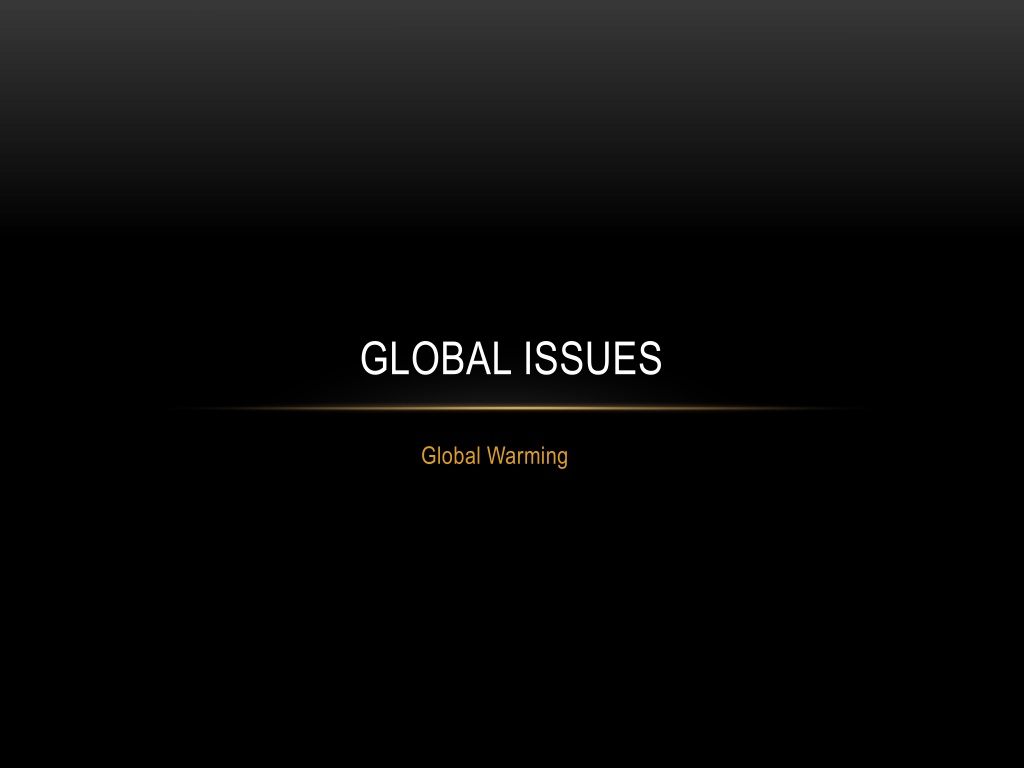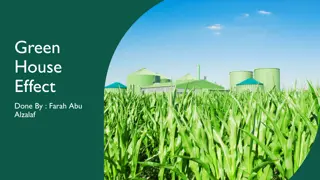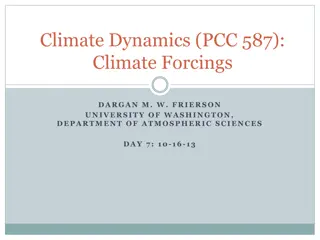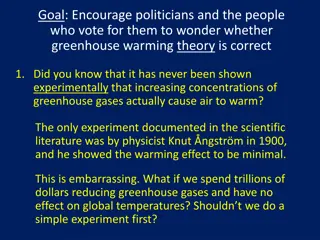Understanding the Greenhouse Effect and Global Warming
The greenhouse effect, caused by gases like carbon dioxide in the atmosphere, is essential for Earth's temperature regulation. However, human activities have led to an enhanced greenhouse effect, resulting in global warming. Learn how this natural process works and its impact on climate change.
Download Presentation

Please find below an Image/Link to download the presentation.
The content on the website is provided AS IS for your information and personal use only. It may not be sold, licensed, or shared on other websites without obtaining consent from the author. Download presentation by click this link. If you encounter any issues during the download, it is possible that the publisher has removed the file from their server.
E N D
Presentation Transcript
GLOBAL ISSUES Global Warming
THE GREENHOUSE EFFECT The greenhouse effect is caused by the gas carbon dioxide (CO2) together with other trace gases in the atmosphere. These gases, commonly called greenhouse gases, provide a blanket that keeps the Earth warm. Too little carbon dioxide, and the planet would be too cold to sustain life. Too much, and the resulting high temperatures would also be unsuitable for life. The greenhouse effect is natural and is required for the continued survival of all Earth s species.
THE HOT CAR EFFECT A car left in the sun on a fine day can become very unpleasant inside. The temperature can easily reach 50 C even when the temperature outside is only between 20 C and 30 C. Heat enters the car easily but much of the heat cannot escape. For this reason, animals and young children should not be left in cars: these high temperatures can kill. The greenhouse effect could well have been called the hot car effect , but it is named after greenhouses that trap heat from the Sun to help plants grow more quickly.
HOW DOES IT WORK? Carbon dioxide and other gases in the atmosphere behave like the glass in a greenhouse or car windows. Energy from the Sun reaches the Earth as electromagnetic waves with a short wavelength. These waves are able to pass through the atmosphere (and glass). The energy is absorbed by the Earth and re-emitted into the atmosphere as long-wavelength radiation. Carbon dioxide (and glass) effectively blocks the transmission of long-wavelength radiation, stopping it from reaching space. Much of this energy is therefore trapped in the atmosphere, warming the Earth to a temperature suitable for life. If not for the greenhouse effect, the Earth would be about 30 C colder on average!
The surface temperature on Mars is 100C. Its atmosphere is too thin to produce a life-sustaining greenhouse effect.
The Earths atmosphere is just the right thickness to keep its average temperature at around 22 C.
A massive greenhouse effect caused by Venuss thick carbon dioxide- rich atmosphere causes surface temperatures of 500 C.
THE ENHANCED GREENHOUSE EFFECT Over the past century the levels of greenhouse gases in the atmosphere, particularly carbon dioxide, have increased. The blanket of greenhouse gases in the Earth s atmosphere has effectively become thicker. This results in the enhanced greenhouse effect, where the same amount of heat energy is coming in from the Sun, but less is escaping back into space. The enhanced greenhouse effect is leading to global warming, increasing the average temperature of Earth.
GREENHOUSE GASES: WHERE DO THEY COME FROM? The main greenhouse gas is carbon dioxide. Carbon dioxide is naturally cycled through the environment during photosynthesis and respiration. Over Earth s history the amount of carbon dioxide in the atmosphere has stayed fairly stable since it is both absorbed into living systems and released back into the atmosphere.
CO2 REVOLUTION The factories, steamships and locomotives of the Industrial Revolution needed fuel to fire their boilers. This came mainly in the form of timber or coal. The modern world also needs fuel. In mainland Australia, coal is still used, mainly to fire the boilers of electrical power stations. Coal, and the other main fuels, gas, petrol and oil, are termed fossil fuels, since they are made from the fossilised remains of long-dead plants and animals. Carbon dioxide is released whenever fossil fuel is burnt. In effect, burning unlocks carbon that has been stored in the Earth for millions of years, producing CO2 as it does so. Car exhausts, coal and gas power stations and industry are leading producers of carbon dioxide. The clearing of land (deforestation) by burning forests has a double effect.
Burning fossil fuels is a leading source of excess CO2 in the atmosphere. Land clearing releases stored CO2 into the air.
Not only are greenhouse gases released when forests burn, but the destroyed trees are no longer available to store carbon dioxide. With our modern demand for fuel and electricity, humans are making more carbon dioxide around 27 billion tonnes per year than ever before. Some is absorbed, but the rest builds up in the atmosphere. Of this 27 billion tonnes of carbon dioxide output, about: 7 billion tonnes are absorbed by oceans 7 billion tonnes are taken up by forests 13 billion tonnes accumulate in the atmosphere each year.
OTHER GASES Although carbon dioxide is the main greenhouse gas, others include the following: Methane (CH4) is produced when vegetation breaks down in the absence of oxygen e.g. in rice paddies and rubbish tips, and when cattle (or you!) burp or pass wind. Methane is 21 times more effective than carbon dioxide in blocking the escape of radiant heat from Earth. Luckily, less methane than carbon dioxide is produced. Nitrous oxide (N2O) is produced from burning forests, car exhausts and artificial fertilisers. CFCs or chlorofluorocarbons were, until recently, used in aerosol spray cans, refrigerators and air conditioners, to clean circuit boards and in the manufacture of polyurethane foam used in packaging. They are now banned in many countries and are becoming less commonly used worldwide. Surface ozone is generated as part of photochemical smog, produced by the action of sunlight on motor vehicle and industrial pollution.
Australia produces approximately 1.4% of the worlds greenhouse gasesper person this makes it one of the world s worst greenhouse-polluting countries. Australian greenhouse gas production (excluding land clearing) Carbon dioxide 60% Methane 26% Nitrous oxide 6% Other 8%
EVIDENCE IN THE ICE Scientists collect ice cores from Antarctica by drilling into the ice. The deeper you go into the ice, the older the ice is, as new snow falls on top each year. When the snow falls, air bubbles are trapped in the ice. Analysis of these trapped gases reveals the amount of carbon dioxide present in the atmosphere in the past. So far scientists have drilled down 3.27 kilometres, which means we have data about carbon dioxide levels going back roughly 900000 years. Antarctica covers twice the area of Australia.
THE FUTURE: PREDICTING THE TEMPERATURE RISE Over the past 100 years or so, the Earth s average surface temperature has increased by about 0.5 C and a further increase of between 1 C and 4 C is expected by the end of this century. Such a rise, though seemingly small, is enough to raise sea levels by an estimated half a metre possibly up to a metre and cause flooding of low-lying coastlines due to the increase of water in the oceans and melting of land ice. Many of the island nations in the Pacific and Indian Oceans would virtually disappear.
PREDICTING LOCAL EFFECTS We do not fully understand the implications of global warming for society and the environment. Some regions will be drier, some wetter, some cooler and most will be hotter. We can also expect more storms, droughts, floods, hurricanes and temperature extremes. Australian scientists predict that some of the following changes may occur: The melting of much of the polar ice caps will raise sea levels, flooding coasts, cities and some entire island countries. Liquid water expands slightly when warmed and so the oceans will expand, also raising sea levels, causing further flooding.
Increases in the numbers of wild storms and cyclones. Cyclones could move further south. More droughts and heatwaves Morebushfires saving water will become more important. Less rain and snow. Managing and Habitats will change, causing the extinction of some animals and plants. Increased temperatures may cause bacteria to grow faster, causing more disease in humans and other organisms. Some plants may grow faster with higher temperatures. This would be good for farmers, but less rain may mean fewer plants grow and fewer varieties can survive. Increased heat may cause more heat stroke and illness.
EL NIO Another factor adding to weather extremes, possibly blurring the effect of global warming, is the El Ni o effect. The water of the Pacific Ocean is warmer than other oceans. In a normal year, trade winds push this warmer water west towards the east coast of Australia, where high levels of evaporation cause normal amounts of rainfall. Every few years, the El Ni o effect occurs, in which trade winds weaken or reverse, allowing warmer water to move towards the west coast of South America around Christmas time (El Ni o means Christ child in Spanish). The result is that Australia experiences drought and South America experiences increased rainfall.























